Wealth is a word that can mean different things to different people. For many, wealth simply means money—and it’s something that only a select few have in abundance. But wealth can mean much more than money.
For example, if you live in the Rocky Mountains or along the upper shores of Lake Michigan, you and your neighbors share a wealth of natural beauty and amenities—this wealth may be the reason you choose to live where you do. Men and women with long experience working in local industries have a wealth of skills and creativity. People who have attended college or specialized training have a wealth of knowledge. Towns that have a range of community-wide activities and active civic groups have a wealth of connections. Young children with access to affordable, preventive pediatric care might count good health as a type of wealth.
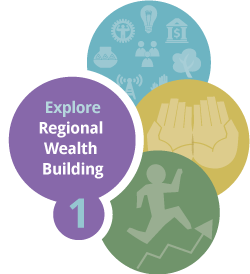

Parts of the Pacific Northwest have a wealth of timber, maintained by private and public landowners, providing employment in many small communities.
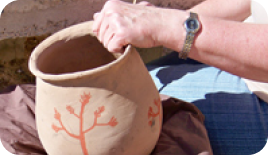
Tribal communities have a wealth of tradition, practices and artistry, shared and maintained by tribal members to provide a sense of belonging, a home, a history—and in some cases, non-profit or for-profit tourism or craft enterprises.
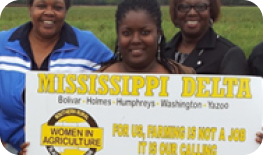
The Black Belt regions of Alabama and Mississippi have a wealth of agricultural knowledge maintained by African American residents that helps keep family, friends, communities and some commercial customers fed.
Notice again, in these examples, wealth is not just about money, but instead represents different types of capital—like natural resources, culture and know-how. When owned or influenced, either individually or collectively, by residents of a region, this capital can be deployed by residents to shape, sustain and improve livelihoods.
WealthWorks helps communities do this by identifying, deploying and investing in existing regional wealth, strengthening local or regional ownership and control of it, and ensuring that many in the region—always including low-income people, places and firms—participate in and reap benefits from economic and community development action. In short, WealthWorks seeks to build regional wealth.
Why WealthWorks? Its focus on regional wealth building creates new possibilities for economic and community development. It helps widen the development focus beyond the core of profit, income and job creation today—the typically stated targets for development—to include the essential factors that will sustain profit, jobs and income into the future. WealthWorks’ wealth-building strategy produces wealth that sticks because it shows how to invest in and increase influence over local assets to produce benefits for the region both today and tomorrow.
To introduce and explore WealthWorks’ potential, this module defines the core concepts and goals of wealth building: wealth, ownership and livelihoods. Then, we explore how you can begin to think about wealth-building in your region.
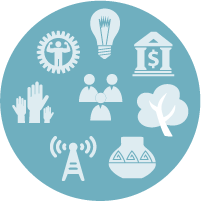
The eight capitals: intellectual, financial, natural, cultural, built, political, individual and social.
To build a region’s wealth, WealthWorks considers not just financial assets, but includes the stock of all capitals in a region. This approach takes into account all the features of a city, town, countryside or region that make it a good place to live, work and visit. These might include: a strong sense of community; good infrastructure (e.g., affordable broadband, good roads, health care); well-trained workers with the right skills to be productive in local businesses; unspoiled natural beauty (e.g., lakes, streams, hiking trails, parks) or natural assets like wetlands that control flood waters; inclusive, open government; a few strong sectors with well-paying jobs and career possibilities.
Each of these represents a component of a type of capital. Some components of capital—like the ones listed above—are more immediately recognizable than others. Some are less visible because they are in disrepair, not used, or taken for granted. Such “underutilized resources,” if identified and invested in, could contribute more to the region’s wealth. For example, a vacant lot considered an eyesore today could, with imagination and investment, become a productive community garden or recreational space tomorrow. Underskilled but willing workers could, with investment in training programs for skills that local firms need, become the region’s strongest asset.

A growing number of economic and community development practitioners are concerned with how to “make wealth stick.”
Classic examples of wealth not “sticking” surface all the time in the hallway conversations about development. In one common case, rural communities lament when they create and offer their high school graduates college scholarships to far-away universities; this builds the youth’s individual capital, but if the young people never return, that capital leaves the region. In another, regions complain when generous public incentives are awarded to large firms to locate there, but the firm is not locally owned, participates little in community life, only offers its lowest-wage jobs to locals, or moves away when a better location deal lures them to a different region.
In short, wealth-building is not just about increasing wealth—that is, the quantity and quality of your stocks of eight capitals. It must include making sure those stocks of capital stay in place and that people, firms, organizations and communities in the region can make decisions about how they are used and invested in the future. In WealthWorks, we call this essential ingredient of wealth building regional ownership and control.

How can this economic development strategy be altered so that those on the margins can participate in its design, and so that they will benefit from it?
The allure of wealth building is its capacity to improve lives. For that reason, the last essential component of wealth building is lasting livelihoods.
You might well work hard to increase stocks of capital, along with local ownership and control, in your region. But if low-income people, places and firms in the region are not doing better or are not well poised to do better, you have not met the WealthWorks test for wealth building.
Why is this so important? It’s because improving livelihoods for low-income people, places and firms is simply good economic strategy. If they stay low-income or fall further down the economic ladder, they have less to spend in your region, fewer family resources—like ready transportation, good health, time or network connections—that enable them to participate in and contribute to the community, and they may create strains on scarce public resources. If they do better, they spend more in the region, their children do better, and they contribute more time, resources and ability to community activities. As low-income people move toward and enter the economic mainstream, everyone does better.
Successful development initiatives require an approach that is right for the market and right for the region. Buyers in the market have specific preferences. Those preferences are better met by certain goods or services than they are others. And regions have unique stocks of capitals—natural resources, built infrastructure, skills, know-how, financing options, influence—that are better suited to address certain development opportunities than others.
The challenge for you as an economic and community development practitioner is to identify a market opportunity that is right for your region. What’s a market opportunity? In WealthWorks, a market opportunity is documented demand for a set of products or services that—with the right set of investments and connections—your region could produce and that has good potential to generate wealth-building results. A market opportunity is a good deal for buyers and a good deal for the region because it represents a situation where you can meet buyers’ demands for products and services while at the same time growing stocks of capitals, increasing local ownership and control, and improving local livelihoods.

There are two major steps to take to winnow down from the big wide wonderful world of market opportunity possibilities to the few that make the most wealth-building sense for your region. Those steps are getting to know demand and matching demand with your region.
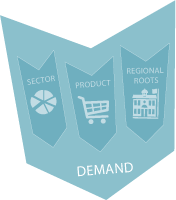
By following one or more of three Scans for Demand, you can target the buyers you want to consult—both inside and outside the region—to find out what products or services they want and are willing to buy.
It makes little sense to set up shop to make a product or provide a service that no one is buying or likely to buy. Yet a lot of effort in economic and community development is focused on producing more of what we already do or make in our region or attracting new industries—without finding out if that’s what buyers want now, or will want tomorrow.
WealthWorks action is built around a market opportunity where you can document demand. And you can document demand because you have established relationships with actual and potential buyers well before you put your development “spade” to the ground.
Of course, there are a lot of buyers out there buying a lot of goods and services. You can’t talk to all of them or research every product or service. So in WealthWorks, you start with what you know about your region to determine the buyers with whom you want to engage. By following one or more of three Scans for Demand, you can target the buyers you want to consult—both inside and outside the region—to find out what products or services they want and are willing to buy.
You might think of each of these scans as a set of conversations in which you are exploring. In fact, looking for market opportunities often sends you in a direction you never thought of before. So it is important to be curious and think outside the box. And none of these scans are mutually exclusive. In fact, one can often lead to another, and it’s quite useful to employ them all—in whatever order makes sense from your starting point—to connect with and better understand potential buyers and an initial set of market opportunities they might represent.
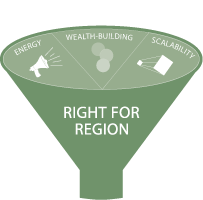
It is important to consider which market opportunities are best suited for your region—meaning they will harness the most local energy, solid wealth-building potential, and capacity to scale into bigger and better results later.
The point of building ongoing relationships with demand is to continually spot market opportunities that have good potential for your region. In WealthWorks, to narrow your selection further, it is important to consider which market opportunities are best suited for your region—meaning they will harness the most local energy, solid wealth-building potential, and capacity to scale into bigger and better results later.
Those three factors can frame how you explore your initial market opportunity options, so that you can move toward selecting one for your WealthWorks value chain.
WealthWorks value chains are well-suited to economic and community development that reaches beyond the norms of “creating jobs” and “increasing income” to achieve broader and deeper wealth-building goals that strengthen and sustain a region’s economy for the longer haul.
WealthWorks value chains offer a practical way to build your stocks of local capital, increase local ownership and control of that capital, and improve livelihoods and upward mobility for people, places and firms within a region. They show how a network of different types of partner investments, coordinated around a true market opportunity, can produce wealth that “sticks” to the region. They move the system of doing economic and community development toward a “new normal”—one where the realization of shared and common interests among value chain partners catalyzes opportunity and creates the will to address challenges together and better utilize all the resources flowing through the value chain to build wealth in the region.
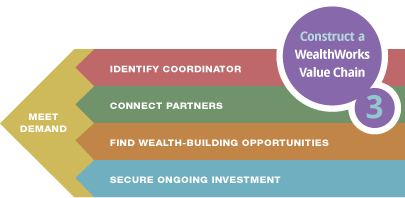

A WealthWorks value chain is a network of people, businesses, organizations and agencies addressing a market opportunity to meet demand for specific products or services—advancing self-interest while building rooted local and regional wealth.
Economic and community development goals tend to drive development practice. When goals are focused primarily on creating jobs and generating income, development activities are designed to produce those results, no matter who gets income, or what kind of jobs they are. In WealthWorks, development goals are expanded to include all three elements of wealth building within a region: that is, boosting stocks of eight types of capital (while harming none), increasing the local ownership and control of that capital within the region, and improving livelihoods, including moving people, places and firms on the economic margins towards the mainstream. Working on that range of goals calls for a tool that is flexible in both its design and application—one that can broaden and deepen wealth-building impacts within a region. That tool is the WealthWorks value chain.

The coordinator serves as the backbone of a WealthWorks value chain, weaving together the efforts of everyone involved.
With multiple players and moving parts, it’s no surprise that WealthWorks value chains need to be guided by a thoughtful and committed coordinator. At the point a critical mass of businesses, organizations, agencies and investors want to act on a market opportunity and build a value chain, they typically agree they must have a coordinator who will serve as the backbone that holds and weaves their efforts together. Anyone might be a coordinator—an organization, a business, an agency or a team. But like any value chain partner, the coordinator, too, must have a vested interest in developing and maintaining the value chain.

There are three primary types of partners in a value chain—demand, transactional and support—and they each play different roles.
WealthWorks considers any person, business, agency or organization that is involved in a value chain a “partner.” Some value chain partners are very involved with the coordinator in thinking about, designing and building the value chain. Some are aware of the chain and supportive, but dip into the work of constructing the value chain only in relation to their specific contribution or connection to its effort. A few partners may be largely unaware they are even in the value chain, but because other partners and the coordinator are aware of those partners’ value, they maintain relationships with them.
Types of value chain partners. There are three primary types of partners in a value chain, and they each play different roles.

Wealth-building opportunities become evident as you map the value chain and identify its gaps, bottlenecks and underutilized resources.
A WealthWorks value chain is dynamic, not static. A large part of its value as a tool for designing and implementing economic and community development efforts lies in that fact. The WealthWorks value chain, when well coordinated, becomes a communication and planning vehicle that surfaces and highlights information that can lead to more wealth-building opportunities.
How does that happen? The coordinator and core partners in a WealthWorks value chain regularly, either through formal meetings or a series of smaller exchanges, discover things happening (or not happening) in the value chain that present a barrier to be tackled or offer an idea for an entrepreneurial venture.
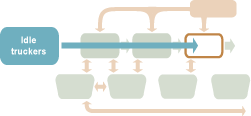
In WealthWorks, investment includes any use or dedication of a capital for wealth-building results. Applying an underutilized resource to fill a gap in the value chain is a wealth-building investment.
Like any economic and community development approach, building a WealthWorks value chain is an undertaking. Identifying the coordinator, spotting the right market opportunities, assembling and connecting partners, finding leverage points and addressing gaps, bottlenecks and underutilized resources is real work. So, like any market-driven approach, it requires investment—not just financial, but investments of creative thinking, willingness to innovate, commitments to doing things differently to create different results—and time.
Think of a WealthWorks value chain as a venture undertaken by a group of investors. Each invests in the value chain to, over time, generate a good return. But WealthWorks investors don’t necessarily invest dollars, and not all value chain investors are looking for financial returns.

Specialties: Local Food, Placemaking, Renewable Energy
States served: Minnesota
Additional details: Enhancing the vitality and quality of life in Cass, Crow Wing, Morrison, Todd and Wadena counties is the mission of Region Five Development Commission. Resiliency, inclusion and collaboration are guiding concepts in achieving mutually shared goals that continue to evolve with local municipalities, state, federal, philanthropic, non-profit and social advocacy agencies.
Contact: Cheryal Lee Hills, 218-894-3233
Mailing address:
200 1st Street NE, Suite 2
Staples, MN 56479
Alternative contact: Dawn Espe, 218-894-3233
Website: http://www.regionfive.org

Specialties: Food, Forestry/wood products, Tourism
States served: Idaho, Oregon, Washington
Additional details: RDI was formed in 1991 in response to the timber industry crisis facing the Pacific Northwest. Our nationally recognized programs and services help communities help themselves with effective and results-oriented training and resources necessary for individuals living in rural communities to build and sustain a better future in their communities. Our work is based upon our genuine commitment to build rural capacity through Leadership Development programs and strengthen Rural Economic Vitality through moving capacity into action.
Contact: Amy Hause, (541) 255-9590
Mailing address:
Rural Development Initiatives
91017 S Willamette St
Coburg, Oregon 97408
Alternative contact: Heidi Khokhar, (541) 684-9077 ext. 7011
Website: http://www.rdiinc.org/

Specialties: Food, Forestry/wood products, Housing, Tourism
States served: Alaska, Arizona, California, Colorado, Hawaii, Idaho, Montana, Nevada, New Mexico, Oregon, Utah, Washington, Wyoming
Region details: RCAC serves 13 western states including: Alaska, Arizona, California, Colorado, Hawaii, Idaho, Montana, Nevada, New Mexico, Oregon, Utah, Washington, and Wyoming. We also work in the U.S. territories of the Marianas Islands, Marshall Islands and the U.S. Virgin Islands.
Additional details: RCAC Value Chains, economic development and Wealth Works are embedded in RCAC’s Building Rural Economies program. With over 10 years of experience in these arenas we technically assist communities who wish to envision and create their future.
Contact:
Carol Cohen, 435-671-7068
Mailing address:
3120 Freeboard Drive
Suite 201
West Sacramento, CA 95691
Alternative contact: Ellen Drew, (575) 421-0261
Website: http://www.rcac.org/community-economic-development/wealthworks-west
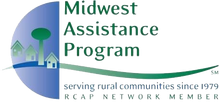
Specialties: Energy efficiency
States served: Iowa, Kansas, Minnesota, Missouri, Montana, Nebraska, North Dakota, South Dakota, Wyoming
Additional details: Midwest Assistance Program (MAP) has been helping communities and tribal nations find solutions to their infrastructure and development needs through information, resource management, expertise, and technical assistance since 1979.
Contact: Chris Fierrros, 660-562-2575
Mailing address:
303 N Market Street, Suite 2
Maryville, MO 64468
Website: http://www.map-inc.org

Specialties: Bio-energy, Food
States served: Arkansas, Louisiana, Mississippi, Oklahoma, Tennessee, Texas
Region details: Communities Unlimited serves seven southern states: Arkansas, Mississippi, Tennessee. Texas, Oklahoma, Louisiana and Alabama. This is an area that includes 60% of this country’s persistently poor counties, including large percentages of African Americans, Hispanics, and Native Americans.
Additional details: Communities Unlimited has 40 years of community economic development experience in the South. It seeks to move rural and under-resourced places toward prosperity by identifying a community’s assets and the market demand for the products or services created from those. We then build value chain collaboratives based on WealthWorks principles to create new economic opportunities. Since 2013, we are demonstrating the success of this approach through a farm-to-fuel value chain in the Arkansas Delta.
Primary Contact:
Martha Claire Bullen, 479-443-2700
Alternative Contact:
Ines Polonius
Mailing address:
3 East Colt Square Drive
Fayetteville, AR 72703
Alternative contact: Debbie Luther, 870-509-1331
Website: https://www.communitiesu.org
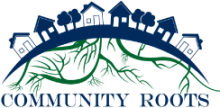
Specialties: Arts, Food, Forestry/wood products, Tourism
States served: Connecticut, Maine, Massachusetts, New Hampshire, New York, Rhode Island, Vermont
Additional details: Community Roots, LLC is a Vermont firm specializing in rural community and economic development consulting. Melissa Levy of Community Roots, LLC has been working with the WealthWorks framework over the past several years. She’s been a trainer, coach, workshop facilitator, and presenter in the WealthWorks community.
Contact: Melissa Levy, 802-318-1720
Location: Hinesburg, VT

Specialties: Arts, Energy efficiency, Food, Forestry/wood products, Manufacturing, Tourism
States served: Kentucky, North Carolina, Ohio, Tennessee, Virginia, West Virginia
Additional details: The Central Appalachian Network is a regional network of six anchor organizations that pursue collective sustainable economic development strategies across the Appalachian region of Ohio, West Virginia, Kentucky, Virginia, and Tennessee. CAN builds regional partnerships and also works deeply at the sub-regional level around sectors and opportunities including local food value chains, forestry, new energy, small business development, social enterprise, recycling/upcycling, implementation-focused research, advocacy, and organizational capacity-building. CAN’s members are Appalachian Center for Economic Networks (ACEnet), Appalachian Sustainable Development (ASD), Coalfield Development Corporation, Community Farm Alliance (CFA), Mountain Association for Community Economic Development (MACED), Natural Capital Investment Fund (NCIF), and Rural Action.
Contact: Leslie Schaller, 740-592-3854
Mailing address:
1456 C Patton Avenue
Asheville, NC 28806
Website: https://www.cannetwork.org